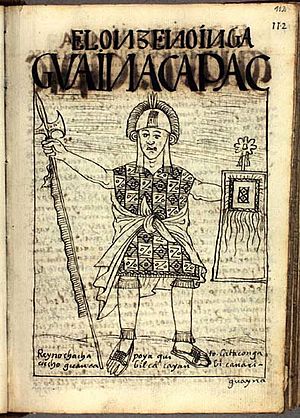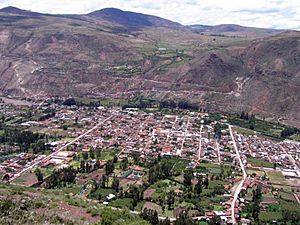Quispiguanca facts for kids
Quispiguanca, also known as Q'espihuanca or Q'espiwanka, was a special country home built for the Inca emperor Huayna Capac. He ruled a long time ago, from about 1464 to 1525 CE. You can find the remains of this estate in the northern part of Urubamba, Peru, a town in Peru. It's located high up in the mountains, at about 2,910 metres (9,550 ft) above sea level.
Contents
Why Inca Emperors Built Estates
Inca emperors often built large royal estates like Quispiguanca. These estates helped them become even more powerful and wealthy. They were also passed down to their children and family members. Royal estates served as beautiful country palaces. Sometimes, they even acted as strong forts to protect against rivals who wanted power.
You can find the ruins of other Inca royal estates, like Huchuy Qosqo and Machu Picchu, all along the Urubamba or Yucay Valley. This area is often called the Sacred Valley.
The Sacred Valley was a very popular place for royal estates. It was only about 30 kilometres (19 mi) away from Cuzco, the Inca capital. But the valley was lower down and had a warmer climate. This warmer weather was perfect for growing Maize, which was a very important crop for the Incas. Near Cuzco, it was usually too cold to grow maize.
The Sacred Valley was also the easiest way to reach areas where coca was grown. Coca was another important plant for the Incas. The valley had plenty of water from the snow-covered Andes mountains. These mountains rise to more than 5,000 metres (16,000 ft) on the north side of the valley.
The Royal Estate of Quispiguanca
The estate of Huayna Capac stretched for about 15 kilometres (9.3 mi) along the Sacred Valley. Before the estate was built, four groups of people lived on this land: the Pacos, Chichos, Cachis, and Chaocas. They continued to work on the estate as yanakunas, who were like special servants.
Huayna Capac also brought in 2,000 people from other places to live and work on the estate. This was part of a system called mitma. Spanish records say that the emperor gathered a huge workforce of 150,000 men. These men did massive jobs like changing the path of the Urubamba River, draining wet areas, and building farm terraces called andenes. They also built irrigation canals, roads, bridges, ponds, and parks. And, of course, they built Huayna Capac's main palace at Quispiguanca, plus other smaller palaces.
Once finished, the estate had huge fields of maize, potatoes, and chile peppers. It also grew crops brought from other parts of the Inca Empire, such as coca, peanuts, cotton, and sweet potatoes. Forests were planted or managed for hunting by the emperor. They also provided wood for fires and building.
Not all the land on the estate belonged only to the emperor. He gave some land to his mother, other relatives, his wives, and religious groups. He also gave land to a group of special women called aclla. The Spanish often compared these women to nuns.
What's Left of Quispiguanca Today
Today, the area where Huayna Capac's palace of Quispiguanca once stood is a modern cemetery and fields growing carrots and cilantro.
What remains of the ancient buildings are a terrace, a well-preserved wall, and gatehouses on the east side. There are also several buildings in poor condition in the northern part of the site. Most of the construction used carefully fitted stones. However, some parts also used adobe (mud bricks) and plaster.
The original palace area was shaped like a rectangle. It measured about 189 metres (620 ft) from north to south and 125 metres (410 ft) from east to west. A terrace about 4 metres (13 ft) high made the ground level inside the walls.
The northernmost part of the estate has farm terraces and the stone foundation of a large hall. This hall measured about 14 metres (46 ft) by 44 metres (144 ft). Another similar large hall was nearby, along with smaller buildings. The middle part of the estate was a big open plaza. This plaza made up most of the site's area. In its center was a large white rock, which likely had religious meaning. A small Catholic chapel now stands at the exact center of the plaza. It might be built over an older Inca religious structure.
Quispiguanca Under Spanish Rule
Francisco Pizarro, the Spanish leader who conquered the Inca Empire, took over Huayna Capac's estate in the 1530s. This was part of a system called encomienda. The people living on the estate then worked for Pizarro. At first, they gave their labor, just as they had for Huayna Capac. Later, they gave a set amount of their farm produce.
After Pizarro was killed in 1541, a Cañari Indian named Francisco Chilche claimed to be the leader of much of the Quispiguanca estate's land. He managed to keep other Indian rivals and Spaniards from taking the land. The Cañari people had helped the Spanish overthrow the Inca Empire, so they had some legal rights with the Spanish. Chilche remained important into the 1570s. He even gathered 500 Indian soldiers to fight with the Spanish against the last Inca ruler, Tupac Amaru.
The number of people living at Quispiguanca quickly dropped during the Spanish period. This was due to European diseases and civil wars. In 1551, only 800 people lived on the estate. This was much less than the 2,000 mitma families who had settled there during Huayna Capac's time.



